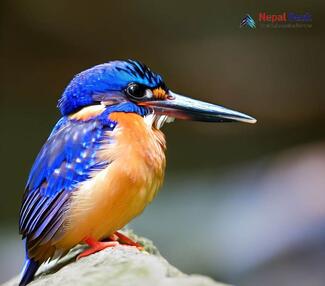Nestled among the spectacular landscapes and rich biodiversity in Nepal, one can find a true hidden treasure: the Blue-eared Kingfisher. This stunning bird displays a striking color palette that makes it stand out among its peers. It's a treat for bird enthusiasts and nature lovers alike. In this article, we'll delve into the fascinating world of this rare kingfisher species found in the charming and diverse region of Nepal.
A Closer Look at the Blue-eared Kingfisher
The Blue-eared Kingfisher (Alcedo meninting) is a small-sized bird measuring around 16 cm long and weighing between 25-35 grams. The dazzling combination of its bright blue and rusty orange plumage is sure to captivate anyone who spots it. These birds have a distinctive blue ear patch, located just behind each eye, which is the origin of their name. However, despite their vibrant colors, they have proven to be quite elusive due to their preference for thick, dense vegetation near water sources.
Habitat and Distribution in Nepal
The Blue-eared Kingfisher thrives in well-shaded areas such as dense forests and mangroves found near slow-moving or stagnant water bodies like rivers, streams, ponds, and swamps. In Nepal specifically, these birds are mostly seen near Chitwan National Park and surrounding areas. They have also been sporadically reported in some other regions with suitable habitat conditions.
Feeding Habits and Prey Selection
The primary diet of the Blue-eared Kingfisher consists of fish, which they hunt by perching on branches overlooking water sources to keep an eye out for potential prey. Once they spot a meal-to-be, they swiftly dive into the water to snatch their target with their sharp beaks and return to their perch to consume it. These agile birds also occasionally include aquatic insects and other invertebrates in their diet.
Conservation Status and Efforts
Currently listed as a species of "Least Concern" by the IUCN Red List, the Blue-eared Kingfisher is not considered threatened on a global scale. Nonetheless, their elusive nature combined with habitat loss due to deforestation and pollution requires continued monitoring to ensure their existence in Nepal and other countries across Southeast Asia.
In conclusion, the Blue-eared Kingfisher is a captivating gem that can be found in the biodiverse nation of Nepal. As one of the many hidden treasures awaiting discovery in this remarkable country, the Blue-eared Kingfisher serves as a symbol of the importance of preserving habitats and ecosystems that nurture such beauty. By continuing conservation efforts, we can ensure that these remarkable birds continue to flourish and enchant future generations with their vibrant colors and resilience.



